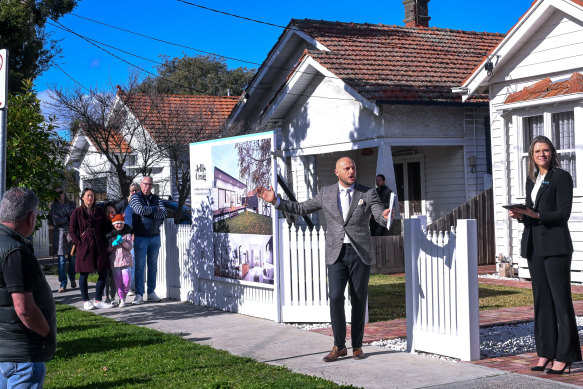This year’s house price rise was a shock. But history left some clues behind
By Jim Malo
The Australian property market has proved shockingly resilient in the face of the sharpest interest rate rise in 30 years, but there is a precedent for the bounce.
Interest rates last rose this quickly in 1994, and both then and now house prices fell at first. Then prices rebounded even before rate cuts gave home buyers more money to spend.
But economists say the current situation and its closest analogue don’t have much in common otherwise, as other factors, such as low volumes of homes for sale, have supported property prices this year.
The Reserve Bank started hiking rates from their record low of 0.1 per cent in May last year and house prices began falling immediately, and in some cases even before.
CoreLogic head of Australian research Eliza Owen said conventional wisdom about the property market taking time to respond to interest rate rises was coming into question.
“I just think the economic conditions we find ourselves in at the moment have just been turned on its head because of the pandemic,” she said. “I don’t think there’s been any data set or indicator that hasn’t been rocked by what we’ve been through in the past three years.”
Rates last rose this quickly in 1994 when the RBA hiked rates 2.75 percentage points over five months. The property market took four months to respond back then — but in 2022, prices began falling Australia-wide in May, the same month as the first hike.
Prices have also risen during the rate rise cycle, which economists say is unusual but not unheard of. In the 1990s, prices started rising 11 months after rates peaked and eight months before rates fell. This time, prices started growing before the cash rate had even peaked — but 10 months after prices began falling and the cash rate started rising. Rate cuts appear some months off.
Owen said prices had been unusually responsive to the changes in the cash rate — which she said had changed because of a rise in consumer attention to the RBA’s hiking cycle.
“People seem to be more tuned in,” she said. “Maybe it’s the availability of that information as well. One week we can be predicting a peak in the cash rate at 3.85 then two weeks later it can be revised that the peak will be 4.35 [per cent].

Rates last rose this quickly in 1994 when the RBA hiked rates 2.75 percentage points over five months. Credit: Eddie Jim
“Maybe that gets the cycle moving earlier and creates positive sentiment in the cash rate even before the peak arrives.”
Separate from this, Owen said the low listing levels, high migration and changes in household size were contributing to the bounce — which most think wouldn’t be happening if more homes were for sale.
AMP chief economist Shane Oliver said he’d never seen property prices react to a rate hiking cycle the way they are now in his decades-long career.
“It’s not just the ’90s rate hiking cycle which makes this one stand out,” he said.
“The normal relationship is rates go up for a while, then you get a weaker jobs market and the impact of rates start to lag and then prices come down. Then it’s only after interest rates fall, prices start to bottom out.
“This time it’s all back to front. Earlier this year [prices] bottomed out and then started rising when rates hadn’t stopped rising.”
Oliver said the cash rate rises were softening demand, but not as much as typically seen in a hiking cycle because key economic indicators like unemployment and international migration were more resilient than expected.
“That squeezed out buyers who are rates sensitive and then pushed other buyers to the side,” he said. “Buyers then found prices turned back up which relates to the massive undersupply of property we’re seeing.
“Normally when interest rates go up migration slows down and unemployment goes up.
“This time around we haven’t seen that.”
The unemployment rate in the 1990s was generally several percentage points higher than now, and the country accepted about a third of the number of international migrants.
Market Economics managing director Stephen Koukoulas said he felt the blame given to interest rates for cutting property prices was overstated and myriad factors influence house prices.
“If you needed any proof that rates going up has only a marginal effect, look at the last two years,” he said. “Often it’s the announcement and the cash flow effect that’s important.”
Koukoulas said low construction approvals would also continue to support prices after building costs went up in the past two to three years.
He said prices rose when the interest rate had peaked in the 1990s for different reasons than now.
“The unemployment rate was much higher. For the ’90s, it averaged about 7 to 8 per cent, that was a negative,” he said. “The availability of credit was a bit better then. It still relatively is, but we know with the APRA rules and the banks tightening up it has changed.”